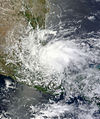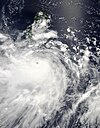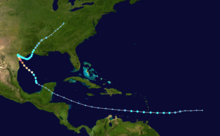Portal:Tropical cyclones
The Tropical Cyclones Portal

A tropical cyclone is a storm system characterized by a large low-pressure center, a closed low-level circulation and a spiral arrangement of numerous thunderstorms that produce strong winds and heavy rainfall. Tropical cyclones feed on the heat released when moist air rises, resulting in condensation of water vapor contained in the moist air. They are fueled by a different heat mechanism than other cyclonic windstorms such as Nor'easters, European windstorms and polar lows, leading to their classification as "warm core" storm systems. Most tropical cyclones originate in the doldrums, approximately ten degrees from the Equator.
The term "tropical" refers to both the geographic origin of these systems, which form almost exclusively in tropical regions of the globe, as well as to their formation in maritime tropical air masses. The term "cyclone" refers to such storms' cyclonic nature, with anticlockwise rotation in the Northern Hemisphere and clockwise rotation in the Southern Hemisphere. Depending on its location and intensity, a tropical cyclone may be referred to by names such as "hurricane", "typhoon", "tropical storm", "cyclonic storm", "tropical depression" or simply "cyclone".
Types of cyclone: 1. A "Typhoon" is a tropical cyclone located in the North-west Pacific Ocean which has the most cyclonic activity and storms occur year-round. 2. A "Hurricane" is also a tropical cyclone located at the North Atlantic Ocean or North-east Pacific Ocean which have an average storm activity and storms typically form between May 15 and November 30. 3. A "Cyclone" is a tropical cyclone that occurs in the South Pacific and Indian Oceans.
Selected named cyclone -
Typhoon Paka, known in the Philippines as Typhoon Rubing, was an extremely powerful and long-lived storm that devastated Guam and the Marshall Islands in December 1997. One of the strongest Pacific typhoons ever recorded in the month of December, Paka was the last tropical cyclone of the 1997 Pacific hurricane and typhoon seasons and the last of a record eleven super typhoons that formed in 1997. Paka, which is the Hawaiian name for Pat, developed on 28 November from a trough well to the southwest of Hawaii. The storm tracked generally westward for much of its duration, and on 7 December it crossed into the western Pacific Ocean. Much of its track was characterized by fluctuations in intensity, and on 10 December the cyclone attained typhoon status as it crossed the Marshall Islands. On 16 December, Paka struck Guam and Rota with winds of 230 km/h (140 mph), and it strengthened further to reach peak winds on 18 December over open waters as the final super typhoon of the year. Subsequently, it underwent a steady weakening trend, and on 23 December Paka dissipated.
Typhoon Paka first impacted the Marshall Islands, where it dropped heavy rainfall and left US$80 million in damages. Later, it passed just north of Guam, where strong winds destroyed about 1,500 buildings and damaged 10,000 more; 5,000 people were left homeless, and the island experienced a complete power outage following the typhoon. Damage on the island totaled US$500 million, which warranted the retirement of its name. Paka also caused minor damage in the Northern Mariana Islands, and overall, the typhoon did not cause any reported fatalities. (Full article...)Selected article -
Hurricane Harvey was the costliest tropical cyclone on record (tied with Hurricane Katrina of 2005), inflicting roughly $125 billion in damage across the Houston metropolitan area and Southeast Texas. It lasted from mid-August until early September 2017, with many records for rainfall and landfall intensity set during that time. The eighth named storm, third hurricane, and first major hurricane of the 2017 Atlantic hurricane season, Harvey originated from a broad area of low pressure southwest of Cape Verde that was first monitored on August 13. Tracking steadily westward, the disturbance developed strong convection, a well-defined circulation, and sustained tropical storm-force winds, leading to the classification of Tropical Storm Harvey late on August 17. Moderate easterly vertical wind shear kept Harvey weak, as it continued westwards into the Caribbean Sea; despite repeated predictions for gradual intensification by the National Hurricane Center, Harvey eventually opened up into a tropical wave on August 19. The remnants of Harvey continued to move westwards and reached the Yucatán Peninsula on August 22, and were forecast to regenerate into a tropical cyclone after exiting land.
On August 23, Harvey moved into the Bay of Campeche and quickly developed a well-defined circulation, becoming a tropical depression later that day and a tropical storm fifteen hours later. Curving northwestwards into a favorable environment with low wind shear and high sea surface temperatures, Harvey began to consolidate and developed an eye. Rapid intensification ensued as Harvey approached the coast of Texas, with Harvey becoming a hurricane in the afternoon of August 24. Despite some dry air entrainment halting the intensification process for the rest of the day, Harvey soon resumed strengthening and became the season's first major hurricane in the evening of August 25. Continuing to deepen, Harvey attained peak intensity with maximum sustained winds of 215 kilometres per hour (130 mph)—Category 4 status on the Saffir–Simpson scale—and a minimum pressure of 937 mbar (27.67 inHg), as it made its first landfall near Rockport, Texas at 03:00 UTC on August 26. This made Harvey the first major hurricane to make landfall in the United States since Wilma in 2005, the first major hurricane in Texas since Bret in 1999, and the strongest in Texas since Carla in 1961. Rapid weakening began as Harvey made a second landfall just north of Holiday Beach three hours after its first, degrading to a tropical storm that evening. Trapped between two ridges to its west and east, Harvey dramatically slowed as it moved inland, but began drifting southeast back towards water on August 27. (Full article...)Selected image -
Selected season -

The 2018 Pacific hurricane season was one of the most active Pacific hurricane seasons on record, producing the highest accumulated cyclone energy value on record in the basin. The season had the fourth-highest number of named storms – 23, tied with 1982. The season also featured eight landfalls, six of which occurred in Mexico. The season officially began on May 15 in the Eastern Pacific, and on June 1 in the Central Pacific; they both ended on November 30. These dates conventionally delimit the period of each year when most tropical cyclones form in the Pacific basin. However, tropical cyclone formation is possible at any time of the year, as illustrated when the first tropical depression formed on May 10, five days prior to the official start of the season.
The second named storm of the season, Hurricane Bud, struck Baja California Sur in mid-June, causing minor damage. Tropical Storm Carlotta stalled offshore of the Mexican coastline, where it also caused minor damage. In early August, Hurricane Hector became one of the few tropical cyclones to cross into the Western Pacific from the Eastern Pacific, while also affecting Hawaii. Tropical Storm Ileana brought torrential rainfall to southwestern Mexico during early August, causing relatively minor damage. A few weeks later, Hurricane Lane obtained Category 5 intensity while also becoming Hawaii's wettest tropical cyclone on record and the second wettest tropical cyclone in United States history, only behind Hurricane Harvey of the previous year. Hurricane Olivia also struck Hawaii, resulting in relatively minor damage. (Full article...)Related portals
Currently active tropical cyclones

Italicized basins are unofficial.
- North Atlantic (2024)
- No active systems
- East and Central Pacific (2024)
- No active systems
- West Pacific (2024)
- No active systems
- North Indian Ocean (2024)
- No active systems
- Mediterranean (2023–24)
- No active systems
- South-West Indian Ocean (2023–24)
- No active systems
- Australian region (2023–24)
- No active systems
- South Pacific (2023–24)
- No active systems
- South Atlantic (2023–24)
- No active systems
Last updated: 07:55, 21 June 2024 (UTC)
Tropical cyclone anniversaries

June 20,
- 2009 - Tropical Storm Linfa reaches peak intensity as a severe tropical storm. Linfa caused damages of about $105 million, mostly from eastern China and Taiwan.
- 2013 - Tropical Storm Barry (pictured) makes landfall over in Veracruz, Mexico, killing only five people in total.

June 21
- 1989 - Hurricane Cosme made landfall over in southern Mexico as a category 1 hurricane killing a total of 30 people.
- 2008 - Typhoon Fengshen (pictured) reached its peak intensity of 200 km/h (125 mph) while moving through the Philippines. Fengshen killed more than 1,300 people mostly from the capsizing of the MV Princess of the Stars.

June 22,
- 1972 - Hurricane Agnes made landfall near New York City. Agnes killed 129 people and caused over $2 billion of damage throughout the eastern United States, with the worst of the damage in the states of Pennsylvania and New York.
- 2015 - Tropical Storm Kujira (pictured) reaches tropical storm intensity before making landfall in southern China. Kujira killed nine people and damaged ¥88 million (US$14.4 million).
Did you know…




- …that the Joint Typhoon Warning Center considers that Typhoon Vera (pictured) of 1986 is actually two distinct systems, formed from two separated low-level circulations?
- …that Hurricane Agatha (pictured) was the strongest Pacific hurricane to make landfall in Mexico in May since records began in 1949?
- …that Cyclone Raquel (track pictured) travelled between the Australian and South Pacific basins between the 2014–15 and 2015–16 seasons, spanning both seasons in both basins?
- …that Cyclone Amphan (pictured) in 2020 was the first storm to be classified as a Super Cyclonic Storm in the Bay of Bengal since 1999?
General images -

The list of North Carolina hurricanes from 1980 to 1999 encompasses approximately 68 tropical or subtropical cyclones that affected the US state of North Carolina. Collectively, cyclones in North Carolina during the time period resulted in around $10 billion in damage (2007 USD), primarily from hurricanes Fran and Floyd. Additionally, tropical cyclones in North Carolina were responsible for about 56 direct fatalities and at least 47 indirect casualties during the period. Eight cyclones affected the state in the 1985 season, which was the year with the most tropical cyclones impacting the state. Every year included at least one tropical cyclone affecting the state. All but two storms were North Atlantic hurricanes; the exceptions were Eastern Pacific hurricanes Tico in 1983 and Roslyn in 1986.
The strongest hurricane to hit the state during the time period was Hurricane Fran in 1996, which struck near Wilmington as a Category 3 hurricane on the Saffir–Simpson hurricane scale; Hurricane Emily in 1993 brushed the Outer Banks also as a Category 3 hurricane. The deadliest hurricane during the period was Hurricane Floyd in 1999, which caused 35 fatalities and record-breaking flooding in the eastern portion of the state. Cyclones affected the state in each month of the hurricane season from June to November, primarily in September. (Full article...)Topics
Subcategories
Related WikiProjects
WikiProject Tropical cyclones is the central point of coordination for Wikipedia's coverage of tropical cyclones. Feel free to help!
WikiProject Weather is the main center point of coordination for Wikipedia's coverage of meteorology in general, and the parent project of WikiProject Tropical cyclones. Three other branches of WikiProject Weather in particular share significant overlaps with WikiProject Tropical cyclones:
- The Non-tropical storms task force coordinates most of Wikipedia's coverage on extratropical cyclones, which tropical cyclones often transition into near the end of their lifespan.
- The Floods task force takes on the scope of flooding events all over the world, with rainfall from tropical cyclones a significant factor in many of them.
- WikiProject Severe weather documents the effects of extreme weather such as tornadoes, which landfalling tropical cyclones can produce.
Things you can do
 |
Here are some tasks awaiting attention:
|
Wikimedia
The following Wikimedia Foundation sister projects provide more on this subject:
-
Commons
Free media repository -
Wikibooks
Free textbooks and manuals -
Wikidata
Free knowledge base -
Wikinews
Free-content news -
Wikiquote
Collection of quotations -
Wikisource
Free-content library -
Wikiversity
Free learning tools -
Wikivoyage
Free travel guide -
Wiktionary
Dictionary and thesaurus

























































